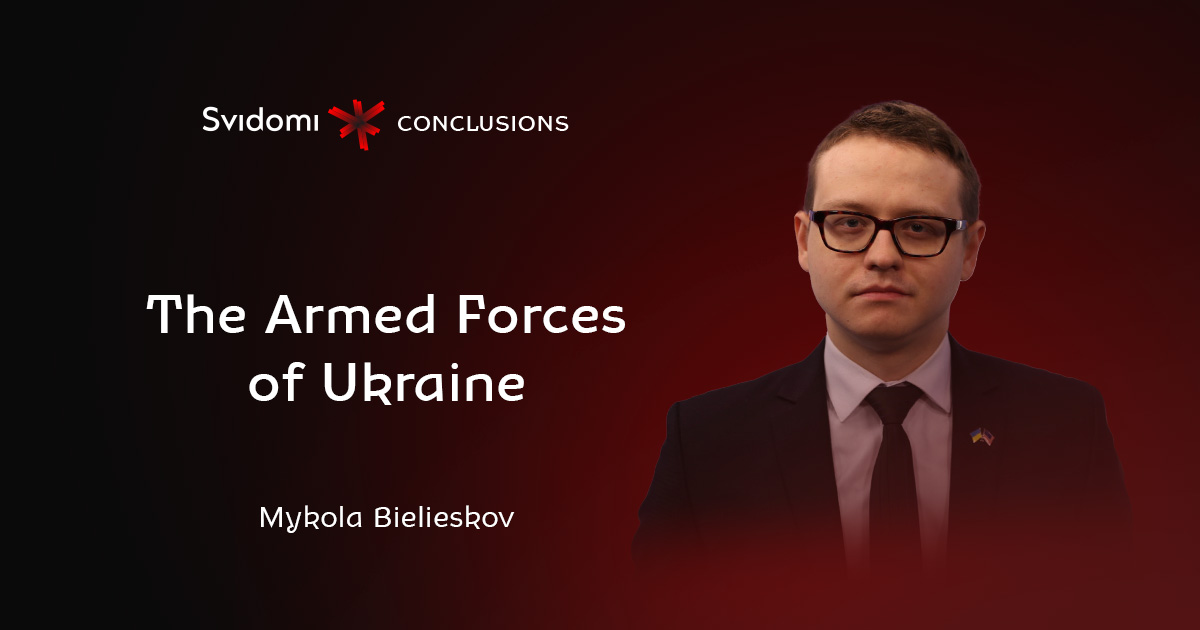Conclusions: The Armed Forces of Ukraine. Mykola Bielieskov

For the third year in a row, at the end of December, Svidomi conducts summary broadcasts on our Ukrainian Instagram page, where it talks about what has changed in Ukraine over the year in various areas: the military, culture, medicine, education, the judiciary and political spheres.
One of the broadcasts in the conclusions marathon is a conversation with Mykola Bielieskov about the Armed Forces of Ukraine.
Mykola Bielieskov is a former analyst at the NGO "Institute of World Politics", since October 2019 he is an analyst at the National Institute for Strategic Studies (Military Policy Department). Since August 2022, he has been a senior analyst at the Come Back Alive foundation.
Strategic defensive operation and strategic initiative
Ukraine's goal during 2022 is to reduce the offensive actions of the Russians, stop them at certain frontiers, inflict the necessary damage, and prepare the prerequisites and conditions for offensive and counter-offensive operations.
A strategic initiative is to force the enemy to play by your rules. When your side dictates when and under what conditions hostilities are conducted. This is the defining thing for achieving the goals in the war. Currently, Ukraine has not yet won the strategic initiative. The struggle for the strategic initiative is still ongoing as the fighting continues. The fact that Russia may have lost the strategic initiative does not mean that we have gained it.
Consequences of the front line reduction
The Russians tried to hold a long front line, which resulted in the Balakliia-Kupiansk operation, and later the actions of the Armed Forces of Ukraine in the Kherson region. As a result of these operations, the front line was shortened, but the density of Russian forces increased. Because of this, further offensive operations planned by Ukraine will require greater efforts, heavy weapons, and equipment.
Because of this, Russia can put pressure on Western countries to persuade Ukraine to negotiate. The main thing for Ukraine is to receive sufficient aid. Russia has a plan not to lose, but that does not mean it cannot be broken.
Why did Russia choose Bakhmut as the main direction?
The Russians have a political intention to establish control over the Donetsk region to sell the population the idea that they have allegedly achieved certain goals. That is, they have a certain declared goal to which they will adhere despite significant losses. Despite the lack of progress, they will continue their actions.
Offensive from Belarus and Moldova
The Russians want to force Ukraine to pull as many forces as possible to the north. At the same time, for this, they need to transfer their groups there because Ukraine has the means to monitor the situation in Belarus. Will blackmail work? This question remains unanswered.
If Ukraine stops resisting, the risks for Moldova will increase. A question arises regarding the position of Moldova, which does not always support the Ukrainian position, because Ukraine guarantees security for Moldova with its resistance. This is not the 1992 situation when Russian forces had potential. The forces that are there are quite limited at the moment.
Russia's unconventional escalation and nuclear threats
The peak of speculations carried out by the Russians in the world ended after China and India declared that they did not accept blackmail from Russia. New attempts at threats cannot be ruled out, but they do not have the effect that Russia would like.
Supply of new types of weapons
The US is unlikely to provide Ukraine with ATACMS missiles. Russia seems to have made America believe that this is the red line of escalation. The US may provide Ground-Launched Small Diameter Bomb ammunition that can hit targets at a distance of 150 kilometers, but it is not yet known whether mass production of these shells is possible.
Expecting that everything will be the way Ukraine wants it is futile. Ukraine and its partners may have different visions of priorities and risks, although interests are mostly common. We should convince partners and look for arguments that will be useful for Ukraine.


